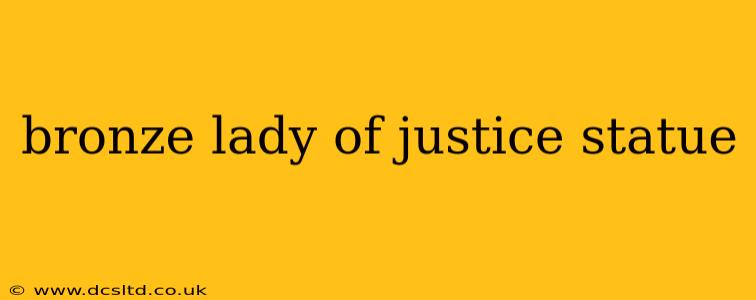The Bronze Lady of Justice, a powerful and enduring symbol of the legal system, captures the essence of fairness, impartiality, and the pursuit of truth. While often depicted as a variation of the more widely known Lady Justice statue (usually in white marble), the bronze rendition offers a unique aesthetic and interpretation of this iconic figure. This article delves into the symbolism, variations, and significance of the bronze Lady of Justice, answering common questions surrounding this compelling representation of justice.
What does the bronze Lady of Justice represent?
The bronze Lady of Justice, like her marble counterpart, embodies the core principles of a just and equitable legal system. Her attributes – the scales, sword, and blindfold – all contribute to a rich tapestry of meaning. The scales represent the weighing of evidence and the impartial consideration of both sides of a case. The sword symbolizes the power of the law and the ability to enforce justice. Finally, the blindfold signifies impartiality and objectivity, ensuring that judgments are not influenced by bias or personal feelings. The bronze material itself adds another layer, possibly suggesting strength, permanence, and the enduring nature of justice.
What is the difference between a bronze and marble Lady Justice statue?
The primary difference lies in the material and the resulting aesthetic. Marble, traditionally associated with purity and classicism, often portrays Lady Justice with a serene, almost ethereal quality. Bronze, on the other hand, lends a sense of weight, permanence, and perhaps even a touch of severity. The bronze's darker hue can also create a more imposing and powerful visual impact. Beyond the material difference, the artistic interpretation can also vary significantly, leading to diverse representations in both materials. Some bronze statues might emphasize a more muscular or dynamic pose, contrasting with the more static postures often seen in marble versions.
Where can I find a bronze Lady Justice statue?
Bronze Lady Justice statues can be found in a variety of locations, depending on their size and purpose. You might find smaller versions in law offices, courtrooms, or even as decorative pieces in private collections. Larger, more monumental statues are frequently placed in public spaces such as courthouses, government buildings, or university campuses. Their placement often reflects the community's commitment to the ideals of justice and the rule of law. Searching online for "bronze Lady Justice statue" will reveal numerous vendors and artists offering a range of styles and sizes. You can also explore local art galleries or antique shops, depending on your location.
How much does a bronze Lady Justice statue cost?
The cost of a bronze Lady Justice statue can vary tremendously, depending on several factors. These include the size of the statue, the level of detail in its craftsmanship, the artist's reputation, and the material used (the purity of the bronze can affect price). Small, decorative pieces might cost a few hundred dollars, while larger, intricately detailed statues can reach tens of thousands or even hundreds of thousands of dollars. It's essential to research and compare prices from different vendors before making a purchase.
What is the symbolism of the blindfold on the Lady Justice statue?
The blindfold is arguably the most recognizable and significant symbol associated with Lady Justice. It unequivocally represents impartiality and objectivity. The blindfold ensures that the scales of justice are balanced without favoritism or prejudice, regardless of the individual's status, wealth, or background. It is a powerful visual reminder that the pursuit of justice should be free from bias and driven solely by the evidence presented.
What are the different interpretations of the Lady Justice statue?
While the core symbolism remains consistent, interpretations of the Lady Justice statue can vary depending on cultural and historical contexts. Some might emphasize the statue's role as a symbol of the legal system's authority, while others might highlight its representation of the ongoing struggle for justice and equality. The artistic style and the specific details of the statue itself can also contribute to diverse interpretations. Furthermore, the material – in this case, bronze – can contribute to the overall impression, as discussed previously.
The bronze Lady of Justice statue serves as a powerful and enduring reminder of the core values underpinning a fair and equitable legal system. Its timeless appeal and enduring symbolism continue to resonate, inspiring both reverence and reflection on the pursuit of justice.
